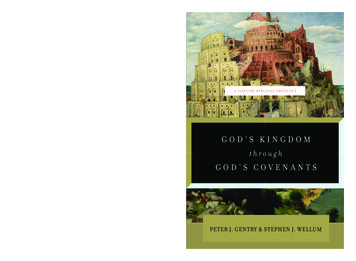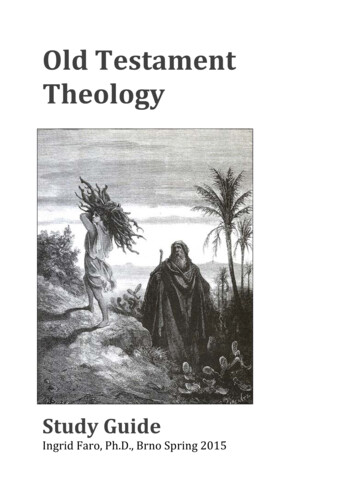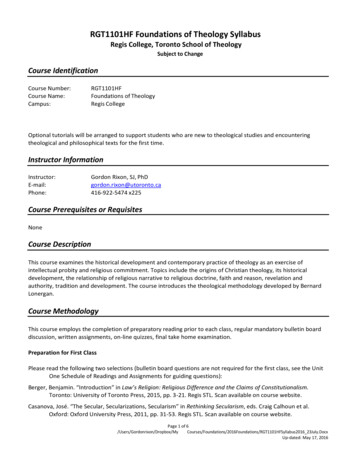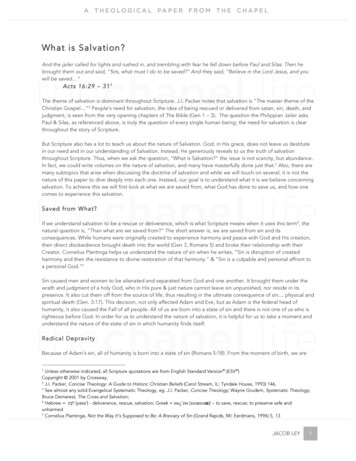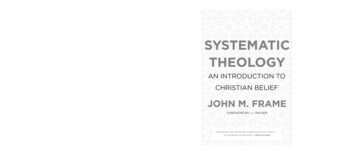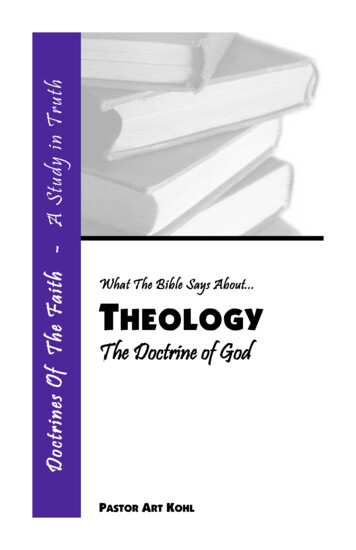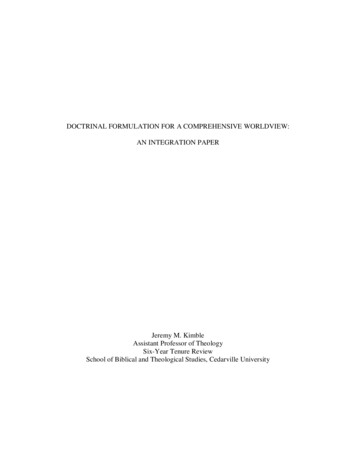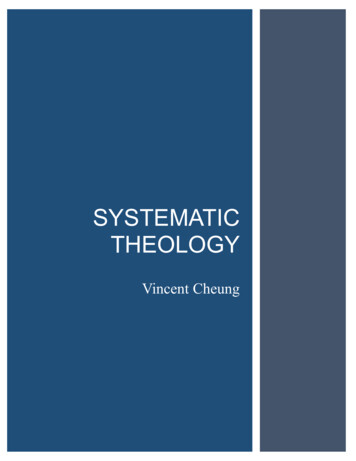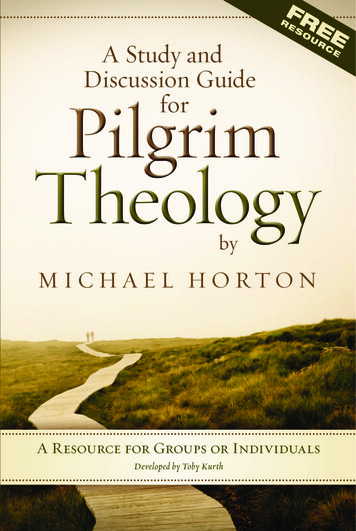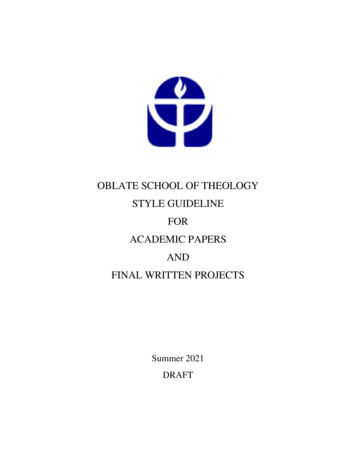
Transcription
OBLATE SCHOOL OF THEOLOGYSTYLE GUIDELINEFORACADEMIC PAPERSANDFINAL WRITTEN PROJECTSSummer 2021DRAFT1
CONTENTSELEMENTS OF STYLE . 1PAGE LAYOUT. 2CITATIONS . 3Quotations . 3Footnotes . 4Place of Publication . 5Standard Formatting Patterns . 5Exceptions to Turabian in Footnotes . 6Bibliography . 6Examples of Citations . 8Book with One Author . 8Book with Two Authors . 8Book with Three or More Authors . 8Book with Two Editors. 8Article in a Journal . 9Article in an Edited Book . 9Chapter in an Edited Volume with Several Authors . 10Biblical Dictionary . 10Biblical Commentaries . 10Classical Texts . 11Editions of the Bible . 11Catholic Church Documents . 12Electronic Media. 14CHAPTER TITLES AND SUBHEADINGS . 18FINAL PROJECTS AND THESES . 19SAMPLE PAGES . 21Title Page for Class Paper . 21Title Page for Thesis . 21Table of Contents . 21Footnotes . 21Bibliography . 21ACADEMIC WRITING RUBRIC . 302
ELEMENTS OF STYLEThe Oblate School of Theology Style Guideline was first written at the request ofstudents seeking guidance about academic writing expectations at Oblate. In response to theirrequest and in an effort to standardize practice across the school, this style guide highlights themost relevant portions of Kate Turabian’s A Manual for Writers of Term Papers, Theses, andDissertations, 9th Edition. Students and instructors are encouraged to refer to this document forguidance about page layout, citations, chapter titles and subheadings, and specific requirementsfor thesis and dissertations. OST Style Guide, Turabian 9, and the Chicago Manuel of Style 17thEdition, could be seen as concentric circles of information. All the information in the StyleGuide is contained within Turabian 9, which is contained within Chicago 17. Students whoencounter style and formatting challenges not included in this guide should refer to Turabian 9 orto the Chicago Manuel of Style 17th Edition. Although inconsistencies may remain, this guide isintended to serve as a model of the academic style and formatting required at Oblate.Elements of style for all papers submitted at the Oblate School of Theology shouldnormally follow the directives contained in Turabian 9. To make formatting with Word lessarduous, Oblate allows a few exceptions to Turabian including page numbering and the format offootnotes. These are described below. Professors may instruct students to use alternativeformatting for some assignments.The use of proper grammar and syntax is presupposed in every written assignment.Students are encouraged to take full advantage of the spell check and grammar check in Wordwith the language preference set to English United States. Additionally, Oblate provides freeaccess to Grammarly, an online editing platform, to all members of the OST community. Forinformation about Grammarly, see the associate academic dean. Submissions containing1
numerous grammatical, syntactical, or formatting errors may be returned to the student forrevision before being read, critiqued, or graded. The use of a willing and competent proofreaderis also recommended. Students who have notable difficulty with style, grammar, and compositionshould seriously consider using the services of a professional editor and taking a compositioncourse at a local college. To help students and faculty evaluated the quality of writing in anassignment, Oblate has created an Academic Writing Rubric, which is included at the end of thisStyle Guide and posted in Moodle.The professional nature of an academic paper requires both a computer with MicrosoftWord software and the use of a high-quality printer. Students are encouraged to seek help withcomputer formatting from the IT director or from the associate academic dean. Althoughstudents may choose to use different word-processing software, Oblate only offers support forMS Word.PAGE LAYOUTThe same page layout is required for all class papers submitted at OST unless theprofessor gives other instructions. (For specific information pertaining to MA theses, doctoralprojects, and dissertations, see Final Projects and Theses below.) Times New Roman font isused throughout the text. The main text is 12-point font and double-spaced and aligned left,which leaves a ragged edge on the right margin. Footnotes are Times New Roman 10 and singlespaced with an additional space between notes. Page numbers are Times New Roman 12 andplaced in the bottom center of the page. Headers and footers are not used except for pagenumbers. Margins (top, bottom, right, and left), are one inch.The first line of each new paragraph is indented one-half inch. The entirety of a boxquote is indented one-half inch and is left justified. An extra space is not added after paragraphs2
or box quotes. Widows and orphans (single lines of text stranded on the top or bottom of a page)should be avoided. The occurrence of widows and orphans can be controlled by clicking widowsand orphans in the paragraph box on MS Word ribbon.CITATIONSIn scholarly and professional work, it is common to use ideas, quotations, and materialsfrom other authors and scholars. This usage occurs in many forms: direct quotations frompublished works and speeches, a synthesis of another person’s ideas or writings, lyrics, poetry,material found on the internet or a person’s web page, and so on. Professional courtesy andacademic integrity require that every use of another person’s work be carefully documented.For information about how to avoid plagiarism, see Turabian 9, section 7.9 “Guard AgainstInadvertent Plagiarism.”1 As described in the OST Student Handbook, intentional acts ofplagiarism lead to severe consequences, including failing grades on papers and even expulsionfrom school.QuotationsA series of words taken directly from another person’s written work or verbal commentsmust be set off with quotation marks. An ellipse, which is three periods separated by spaces . . . ,is used within a quote to indicate that words have been omitted. Ordinarily, Oblate uses the morestraightforward “General Method for Ellipses” (25.3.2.2) rather than the “Textual StudiesMethod for Ellipse” (25.3.2.3). In the general method, an ellipse is not used before or after aquote even if the quote begins or ends in the middle of a sentence. Brackets [ ] are used to1Kate L. Turabian, A Manual for Writers of Research Papers, Theses, and Dissertations: Chicago Style for Studentsand Researchers, 9th ed. (Chicago: University of Chicago Press, 2018), no. 7.9.3
enclose any words added to a quote by the student writing the paper. Examples of both are foundin the quote below explaining the use of block (or box) quotes:If the quotation is four lines or fewer, run it into your text and enclose it in quotationmarks. If it is five lines or longer, set if off as a block quotation [indented, single-spaced,aligned left], without quotation marks. . . . You may use a block quotation for a quotationshorter than five lines if you want to emphasize it or compare it to a longer quotation(25.2).2Notice that you must manually change to single-line spacing for a block quotation, using a blockquotation requires you to manually insert an additional single-space line after the quotation andthen to return to double-spacing your lines.FootnotesAt Oblate, footnotes rather than in-line citations or endnotes are used in all papers. Avariety of software programs, including MS Word, claim to format directly into Turabianapproved style for footnotes and bibliography. Students should not depend exclusively uponsuch programs since occasionally the software is not consistent with the directives provided inTurabian. Even eturabian.com often confuses editors and authors of articles. Students areresponsible for the accuracy of all formatting. At OST, Turabian takes precedence overcomputer-generated formatting.When citing a work the first time, use the full citation as described in Turabian. Ashortened form is used for all subsequent notes. Shortened forms include the author’s last nameand the page number(s). A comma separates the name and page number(s). If more than onework by an author is cited, list the author’s last name, the shortened title, and the page2Turabian, no. 25.2.4
number(s). If there is no author or editor, a title and page number are required (16.4). Forsequential citations of the same source, use a shortened form rather than Ibid. (16.4.2).If you are referring to the same text repeatedly, as this Style Guide does with Turabian 9,you may use parenthetical notes in place of footnotes, as modeled here (16.4.3).Place of PublicationThe place of publication in footnotes and in bibliography entries includes the city andstate or province, the city and country. If the city is known and cannot be confused with anothercity of the same name, then the city only is used. If two or more cities are given, use only thefirst city. If the city of publication might be unknown or confused with another city, then thecapitalized, two-letter postal code abbreviation of the state or province is included. Use currentEnglish names for foreign cites.Standard Formatting PatternsThe following are the standard formatting and information required in a footnote for abook (17.1.6) and a journal article (16.1). In these examples, the XX-XX represents the pagenumber(s) of only those pages on which the information cited is found. Note that thecapitalization of titles in English is distinct from capitalization of titles in non-English works. ForEnglish works, use title capitalization. For non-English works use sentence style capitalizationmeaning only the first word and proper nouns are capitalized.NB:Titles such as Pope, Bishop, Father, Sister, Doctor are not used in footnotes or in thebibliography.Degrees and affiliations, such as O.F.M., O.P., and Ph.D. following a name are omitted.(CMOS14:73)5
For a BookNote NumberAuthor’s First and Last Names, Title of Book: Subtitle of Book, Series [if any] (Place ofPublication: Publisher’s Name, Date of Publication), XX-XX.For a Journal ArticleNote NumberAuthor’s First and Last Names, “Title of Article: Subtitle of Article,” Title of JournalVolume Number Issue Number (Date of Publication), XX-XX.Article on a Website:Note NumberFirst Name Last Name, "Title of Article/Page." Other Contributor(s). Name of WebSite. Last modified Date. accessed date. URL.A collection of commonly-encountered footnote and bibliography situations is includedbelow.Exceptions to Turabian in FootnotesAs strange as it seems, the Turabian default in MS Word for footnotes is not consistentwith the style outlined in Turabian, A Manuel for Writers. Because MS Word is persistent andwill re-format notes even after they are saved, Oblate allows students to use the Turabian defaultwith the two modifications: (1) the font in footnotes must be changed to Times New Roman, and(2) a blank line must be added manually between notes. Otherwise, OST follows MS WordTurabian default: footnotes begin with a superscript number, they are left justified with noindentation, in 10-point font, and single-spaced. MS Word automatically inserts a line betweenyour text and your footnotes. There should not be a space between this line and your firstfootnote. Footnotes are denoted in the main text by using superscripted numbers.BibliographyAt the conclusion of the paper, a bibliography page lists the sources used in the paper.The bibliography is entitled BIBLIOGRAPHY (like a chapter title). With the exception of page6
numbers, the same information is contained in the bibliography as in the footnotes, but the orderand punctuation are altered. In a bibliography:1.Sources are listed in alphabetical order by the author’s (or editor’s) last name, which istherefore placed before the first name and separated from it by a comma. If no author oreditor is given, the entry begins with the title.2.Page numbers are not given for books. However, entire page numbers are given forperiodical articles or chapters in a book. Page numbers are preceded by a colon ratherthan a comma in periodical articles. Page numbers are preceded by a comma in chapterreferences.3.Periods replace some commas.4.Parentheses are not used for the publication information.5.When “Edited by” and “Translated by” follow a title, they are capitalized and spelled out,not abbreviated as in footnotes. When they follow the name of the editor or translator,they are abbreviated.6.The first line of each entry is flush with the left-hand margin; the second line is indentedfive spaces. Each entry is single-spaced with an extra space between entries.The following is the standard formatting and information required in a bibliography entryfor a book.Author’s Last Name, Author’s First Name. Title of Book: Subtitle of Book. Place ofPublication: Publisher’s Name, Date of Publication.When more than one work by the same author, editor, or translator is cited, the entries arealphabetized by the beginning letter of each title, ignoring articles such as a and the. Only thefirst entry contains the author’s name. In subsequent entries, replace the author’s name with atriple em dash (six hyphens) followed by a period (———.).3 When the person listed withmultiple works is the editor or translator rather than the author, place a comma after the em dashand then the correct abbreviation such as ed. or trans (———, ed.). (16.2.2).3There are many ways to insert a triple em dash in a bibliography. Perhaps the easiest to click Ctrl Alt and theminus sign on the number pad three times.7
Examples of CitationsIn the examples below, the footnote entry [N] is followed by the bibliographic entry [B].Book with One AuthorN: Alejandro Garcia-Rivera, The Community of the Beautiful: A Theological Aesthetics(Collegeville, MN: Liturgical Press, 1999), 132.Short form: Garcia-Rivera, 132.If the paper cites more than one work by the same author, include a short title.Garcia-Rivera, Community, 132.B: Garcia-Rivera, Alejandro. The Community of the Beautiful: A Theological Aesthetics.Collegeville, MN: Liturgical Press, 1999.Book with Two AuthorsN: Russell R. Conners and Patrick T. McCormick, Character, Choices, and Community (NewYork: Paulist Press, 1998), 135.Short form:Conners and McCormick, 135.B: Conners, Russell R., and Patrick T. McCormick. Character, Choices, and Community. NewYork: Paulist Press, 1998.Book with Three or More AuthorsN: William V. D’Antonio, James D. Davidson, Dean R. Hoge, and Mary L. Gautier, CatholicLaity: Their Faith and Their Church (Lanham, MD: Rowman and Littlefield, 2007), 122.B: D’Antonio, William V., James D. Davidson, Dean R. Hoge, and Mary L. Gautier. CatholicLaity: Their Faith and Their Church. Lanham, MD: Rowman and Littlefield, 2007.Book with Two or Three EditorsN: Wes Howard-Brook and Sharon Ringe, eds., The New Testament: Introducing the Way ofDiscipleship (Maryknoll, NY: Orbis, 2002), 142.B: Howard-Brook, Wes, and Sharon Ringe, eds. The New Testament: Introducing the Way ofDiscipleship. Maryknoll, NY: Orbis, 2002.8
Book with Four to Ten Authors or EditorsNB:For sources with more than ten authors or editors, include only the first seven in thebibliography, followed by et al. (CMOS 14.76)N: Julie Evans et al., Equal Subjects, Unequal Rights: Indigenous Peoples in British SettlerSocieties (Manchester: Manchester University Press, 2003), 29.B: Evans, Julie, Patricia Grimshaw, David Philips, and Shurlee Swain. Equal Subjects, UnequalRights:Indigenous Peoples in British Settler Societies. Manchester: Manchester UniversityPress, 2003.Article in a JournalN: Raymond F. Person, “The Ancient Israelite Scribe as Performer,” Journal of BiblicalLiterature 117, no. 4 (1998), 603.Short form: Person, 603.If the paper cites more than one article by the same author, include a short title.Person, “Ancient Israelite,” 603.B: Person, Raymond F. “The Ancient Israelite Scribe as Performer.” Journal of BiblicalLiterature 117, no. 4 (1998): 601-9.N: Sana Loue, “Parentally Mandated Religious Healing for Children: A Therapeutic JusticeApproach.” Journal of Law and Religion XXVII, no.1 (2011-12): 400-2.B: Loue, Sana. “Parentally Mandated Religious Healing for Children: A Therapeutic JusticeApproach.” Journal of Law and Religion XXVII, no.1 (2011-12): 397-422.Article in an Edited BookN: Teresa J. Hornsby, “Why is She Crying: A Feminist Interpretation of Luke 7, 35-50,” inEscaping Eden: New Feminist Perspectives on the Bible, ed. Harold C. Washington, Susan L.Graham and Pamela Lee Thimmes (Sheffield, England: Sheffield Academic Press, 1998), 93.B: Hornsby, Teresa J. “Why is She Crying: A Feminist Interpretation of Luke 7, 35-50.” InEscaping Eden: New Feminist Perspectives on the Bible. Edited by Harold C.Washington, Susan L. Graham, and Pamela Lee Thimmes. (91-103). Sheffield,England: Sheffield Academic Press, 1998.N: James Strahan, “First-Born (Hebrew),” in Encyclopedia of Religion and Ethics, vol. VI, ed.James Hastings (New York: Charles Scribner’s Sons, 1924), 35.9
B: Strahan, James. “First-Born (Hebrew).” In Encyclopedia of Religion and Ethics, Vol. VI.Edited by James Hastings, 35-36. New York: Charles Scribner’s Sons, 1924.Chapter in an Edited Volume with Several Authors (16.1)N: Marina Herrera, “The Context and Development of Ecclesial Leadership,” in HispanicCatholic Culture in the U.S.: Issues and Concerns, ed. Jay P. Dolan and Allan Figueroa Deck(Notre Dame: University of Notre Dame, 1994), 180.B: Herrera, Marina. “The Context and Development of Ecclesial Leadership.” In HispanicCatholic Culture in the U.S.: Issues and Concerns. Edited by Jay P. Dolan and AllanFigueroa Deck, 166-205. Notre Dame: University of Notre Dame Press, 1994.Biblical Dictionary (17.1.8 )N: Ronald F. Hock, “Economics in New Testament Times,” in Harper’s Bible Dictionary, ed.Paul J. Achtemeier (San Francisco: Harper, 1985), 240.B: Hock, Ronald F. “Economics in New Testament Times.” In Harper’s Bible Dictionary.Edited by Paul J. Achtemeier, [inclusive pages]. San Francisco: Harper, 1985.N: George, Buttrick, ed., “Luke, Gospel Of,” in The Interpreter’s Dictionary of the Bible. vol. 3(New York: Abingdon Press, 1962), 181, 183.B: Buttrick, George. ed. “Luke, Gospel Of.” In The Interpreter’s Dictionary of the Bible. Vol. 3.180-188. New York: Abingdon Press, 1962.Biblical CommentariesSingle VolumeN: Joseph A. Fitzmyer, S.J., “Pauline Theology,” in The New Jerome Biblical Commentary, ed.Raymond E. Brown, Joseph A. Fitzmyer, and Roland E. Murphy. (Englewood Cliffs: PrenticeHall, 1990), 82:61 [i.e., section and paragraph number, not page number. Only use page numbersis there are not section or paragraph numbers].B: Fitzmyer, Joseph A. “Pauline Theology.” In The New Jerome Biblical Commentary, Editedby Raymond E. Brown, Joseph A. Fitzmyer, and Roland E. Murphy, section 82.Englewood Cliffs: Prentice Hall, 1990.Multiple VolumesN: Robert B. Coote, “The Book of Joshua,” in The New Interpreter’s Bible, ed. Leander E. Keck(Nashville: Abingdon Press, 1994), 2:602.10
B: Coote, Robert B. “The Book of Joshua.” In The New Interpreter’s Bible, Edited byLeander E. Keck, vol. 2, 553-719. Nashville: Abingdon Press, 1994.Book-length Commentary without Series NumberN: John Bright, Jeremiah, The Anchor Bible (Garden City, NY: Doubleday, 1965), 60.B: Bright, John. Jeremiah. The Anchor Bible. Garden City, NY: Doubleday, 1965.Book-length Commentary with Series NumberN: Luke Timothy Johnson, The Gospel of Luke, vol. 3 of Sacra Pagina Series, ed. Daniel J.Harrington, S.J. (Collegeville, MN: Liturgical Press, 1991), 132.B: Johnson, Luke Timothy. The Gospel of Luke. Vol. 3 of Sacra Pagina Series. Edited by DanielJ. Harrington, S.J. Collegeville, MN: Liturgical Press, 1991.NB:Please note in this commonly used source that the words Sacra Pagina are italicized onlybecause they are in a language other than English and not because they are the title of theseries. A title of a series is not italicized if it is in English.Classical TextsN: Therese of Lisieux, Story of a Soul: The Autobiography of St. Therese of Lisieux, trans. JohnClarke, (Washington, DC: 1972), 35.B: Therese of Lisieux, Story of a Soul: The Autobiography of St. Therese of Lisieux. Translatedby John Clarke. Washington, DC: 1972.Editions of the BibleIt is not necessary to list the Bible in your bibliography. Bible citations are not footnotedbut put in parentheses after the quote. The edition of the Bible must be indicated by its italicizedabbreviation. E.g. (1 Tim 3:12 NAB). This is only necessary the first time the Bible is cited if thesame edition is used throughout your text. If you cite more than one edition of the Bible, it mustbe clear which edition you are citing each time. You must also be consistent in using theabbreviations for the books of the Bible designated by the edition of the Bible which you areusing.11
Catholic Church DocumentsPapal DocumentsN: Francis, Laudato Si’, (Vatican City: Vatican Press, 2015), no. 31.B: Francis. Laudato Si’. Vatican City: Vatican Press, 2015.N: Benedict XVI, The Environment, ed. Jacquelyn Lindsey, (Huntington, IN: Our SundayVisitor, 2012) nos.49-57.B: Benedict XVI. The Environment. Edited by Jacquelyn Lindsey. Huntington, IN: Our SundayVisitor, 2012.Canon LawThe 1917 Code of Canon LawN: Codex iuris canonici, Pii X Pontificis Maximi iussu digestus, Benedicti Papae XV auctoritatepromulgatus, Romae, Typis polyglottis Vaticanis, 1917. English translation, Peter CardinalGasparri, (trans.), The 1917 Pio-Benedictine Code of Canon Law, San Francisco, CA, IgnatiusPress. 2001.Short form:CIC17.B: Codex iuris canonici. Pii X Pontificis Maximi iussu digestus, Benedicti Papae XVauctoritate promulgatus, Romae, Typis polyglottis Vaticanis, 1917. EnglishTranslation. Translated by Peter Cardinal Gasparri. The 1917 Pio-Benedictine Code ofCanon Law. San Francisco, CA: Ignatius Press, 2001.The 1983 Code of Canon LawN: Codex iuris canonici, auctoritate Ioannis Pauli PP. II promulgatus Vatican City, Libreriaeditrice Vaticana, 1983. British version of the English-language translation: The Code of CanonLaw: New Revised English Translation, prepared under the auspices of The Canon Law Societyof Great Britain and Ireland in association with The Canon Law Society of Australia and NewZealand and The Canadian Canon Law Society, London, Harper Collins, 1997.Short form:CIC83.B: Codex iuris canonici, auctoritate Ioannis Pauli PP. II promulgatus, Vatican City, Libreriaeditrice Vaticana, 1983. American version of the English-language translation: Code ofCanon Law, Latin-English Edition, translation prepared under the auspices of the CanonLaw Society of America, Washington, DC, Canon Law Society of America, 1999.12
Commentary on the CodeN: Francis Schneider, “Chapter II: The Enrolment, or Incardination, of Clerics [cc. 265-272],” inNew Commentary on the Code of Canon Law, commissioned by the Canon Law Society ofAmerica, eds. John Beal, James Coriden and Thomas Green (Mahwah, NJ: Paulist Press, 2000),329-30.B: Schneider, Francis. “Chapter II: The Enrolment, or Incardination, of Clerics [cc. 265- 272],”In New Commentary on the Code of Canon Law, commissioned by the Canon LawSociety of America, Edited by John Beal, James Coriden and Thomas Green. Mahwah,NJ: Paulist Press, 2000, 329-342.The CatechismN: Catechism of the Catholic Church, Revised in Accordance with the Official Latin TextPromulgated by Pope John Paul II, 2nd ed., (Washington, DC: United States CatholicConference, 1997). no. 339.Short form: CCC, no. 339.B: Catechism of the Catholic Church. Revised in Accordance with the Official Latin TextPromulgated by Pope John Paul II. 2nd Edition. Washington, DC: United States CatholicConference. 1997.RCIAN: Rite of Christian Initiation of Adults: Approved for Use in the Dioceses of the United States ofAmerica by the National Conference of Catholic Bishops and Confirmed by the Apostolic See,Study ed. (Washington, DC: United States Catholic Conference, 1988), no. 35.B: Rite of Christian Initiation of Adults: Approved for Use in the Dioceses of the United Statesof America by the National Conference of Catholic Bishops and the Confirmed by theApostolic See. Study Edition. Washington, DC: United States Catholic Conference, 1988.Roman PontificalN: Congregation for Divine Worship and the Discipline of the Sacraments, Vox ClaraCommittee, “Ordination of a Bishop,” in The Roman Pontifical. Promulgated by Authority ofPope Paul VI and Revised at the Direction of Pope John Paul II. (Vatican City, 2012) 19-62.The Roman Pontifical is generally not included in the bibliography unless it is part of a separatelist of official documents used.LectionaryN: United States Conference of Catholic Bishops, Bishops' Committee on the Liturgy.Lectionary for Mass, Vol III (Totowa, NJ: Catholic Book Publishing, 2002), 38.13
B: United States Conference of Catholic Bishops. Bishops' Committee on the Liturgy.Lectionary for Mass, Vol III. Totowa, NJ: Catholic Book Publishing, 2002.Second Vatican Council DocumentsN: Second Vatican Council, Gaudium et spes, Vatican Council II, Volume 1: The Conciliar andPostconciliar Documents, ed. Austin Flannery, new rev. ed. (Northport, NY: Costello PublishingCo., 1992), no. 48.Short form for subsequent citations of the same document:N: Second Vatican Council, Gaudium et spes, no. 48.Short form for subsequent citations from a different document (first mention):N: Second Vatican Council, Ad gentes, no. 12, Flannery, Vatican Council II.B: Flannery, Austin, ed. Vatican Council II, Volume 1: The Conciliar and PostconciliarDocuments. New Revised Edition. Northport, NY: Costello Publishing Co., 1992.USCCB DocumentsN: United States Conference of Catholic Bishops, Program of Priestly Formation, 5th ed.(Washington, DC: United States Conference of Catholic Bishops, 2006), no. 74.B: United States Conference of Catholic Bishops. Program of Priestly Formation. 5th Edition.Washington, DC: United States Conference of Catholic Bishops. 2006.N.B.Before 2001, the US bishops acting jointly were known as the National Conference ofCatholic Bishops, and their documents were published by the United States CatholicConference. Thus these titles should be used respectively for ‘author’ and publisher of thebishops’ documents before 2001, as the documents themselves should make clear.N: National Conference of Catholic Bishops and Hugh J Nolan. Pastoral Letters of the UnitedStates Catholic Bishops: Volume V. 1983-1988 ed. (Washington, DC: United StatesCatholic Conference, 1990), no. 15.B: National Conference of Catholic Bishops and Hugh J Nolan. P
most relevant portions of Kate Turabian’s A Manual for Writers of Term Papers, Theses, and Dissertations, 9th Edition. Students and instructors are encouraged to refer to this document for guidance about page layout, citations, chapter titles and subheadings
